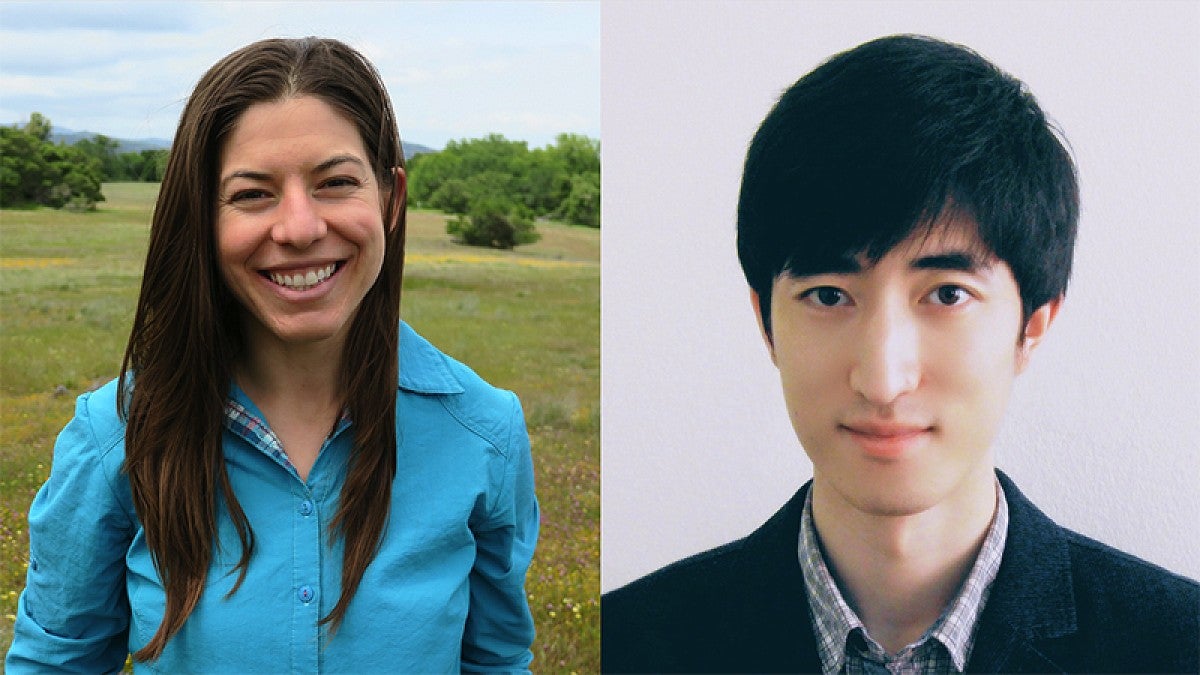Plant community ecologist Lauren Hallett and computer scientist Lei Jiao are getting a boost from the National Science Foundation through prestigious Career Awards, which are among the most sought-after grants from the foundation.
Hallett is examining how species coexist in the face of climate and other environmental variability. Jiao is exploring new ways to make artificial intelligence more accessible to users.
Career Awards support early career faculty who have the potential to serve as academic role models in research and education and to lead advances in the mission of their department or organization.
Hallett’s five-year, $708,011 research project, “Top-down and bottom-up controls on species coexistence in a variable world,” examines the processes that shape biodiversity and how they are being affected by climate change. Specifically, she studies how “bottom-up” processes like resource availability and “top-down” processes such as grazing animals and temporal dynamics like rainfall variability interact to affect ecosystems.
“The overall goal of this project is to advance our understanding of the processes that maintain plant biodiversity and to further the capacity to predict how biodiversity will respond to global change,” said Hallett, an assistant professor in the Department of Biology and the Environmental Studies Program.
The project is affiliated with a larger initiative known as the Nutrient Network, which involves investigators conducting experiments at 130 sites over six continents to identify how ecosystems respond to nutrient enrichment. For her part, Hallett will focus primarily on a unique type of California grassland where a combination of factors — low nutrients and freely draining soils — have created an environment that is more resistant to nonnative grasses.
At the same time, the area has been increasingly enriched by nitrogen due to industry, automobiles and other human factors, which in combination with high rainfall years can enable nonnative plants to invade the ecosystem. One strategy to prevent these nonnative species from taking over too much real estate has been to introduce cattle to graze on the taller, nonnative grasses.
“I think this research is important for a couple of reasons,” Hallett said. “From a theoretical standpoint, the relationship between top-down and bottom-up dynamics has been a central question in ecology, and this work bridges that basic foundation of ecology with some modern theory of how species coexist. And also, understanding how global change is affecting the coexistence of species is really important for their conservation and identifying management actions that can offset the effect of global change.”
In addition to integrating research and educational aims by involving undergraduate and graduate students in data collection, management and synthesis, Hallett’s project also will support students leading their own research projects using data collected from Nutrient Network sites at the H.J. Andrews Experimental Forest on the McKenzie River.
Jiao’s five-year $510,814 project, “Orchestrating Edge Infrastructures and Mobile Devices under Uncertainty to Provision Edge AI as a Service,” explores some of the new ways in which computer and mobile phone users can better access artificial intelligence.
Artificial intelligence, Jiao said, needs to be trained first before using, and training requires accessing massive amounts of data via the internet. Under current systems, the process of training artificial intelligence can be slow due to network delays or even stalled out completely due to internet connectivity issues.
“This training process is performed in remote data centers which are very far away from users like you and me,” said Jiao, an assistant professor in the Department of Computer and Information Science. “It’s unrealistic for users to upload huge amounts of their data through the internet to remote centers for training artificial intelligence model. Users may also be unwilling to do that due to privacy concerns. What I propose with this project is that, rather than moving data to artificial intelligence, we should move artificial intelligence to the data.”
To do that, Jiao will develop new methods of training and using artificial intelligence that take place closer to work or home, what he and others call the “network edge,” which is the opposite of the big data centers that reside at the “network core.” The new paradigm shift could involve the use of a small neighborhood or campus data center, a base station for the cellular network or even a future-generation Wi-Fi router outfitted with a small amount of computing power.
“The trend is that more computation and communication will occur at the network edge,” Jiao said. “Given that trend, how can we revolutionize artificial intelligence in order to make it more accessible to a large number of users at different locations via those distributed edge computing facilities?”
Jiao plans to provide algorithms, mathematical proofs and software that will demonstrate that artificial intelligence can be proficient when taking place in closer proximity to users. The broader impacts portion of his research will involve contributing to undergraduate and graduate student course materials, and providing basic training to K-12 teachers to better equip the next generation of students for the future of artificial intelligence.
“Climate change and artificial intelligence are two highly relevant topics that are ripe for scientific inquiry and we are fortunate to be able to count professors Hallett and Jiao among our outstanding early career researchers,” said Cass Moseley, interim vice president for research and innovation. “We congratulate them on their well-deserved awards, which are a testament to the high caliber of their work, and their promising futures. I look forward to seeing the results of both of these important projects.”
—By Lewis Taylor, University Communications


